There are few industries as complex as energy.
Impacted by factors that range from the weather to geopolitical tensions, the production and consumption of energy has always been complicated.
We’re in a new energy environment today that requires consumers to play a much more active role. In this section, we're exploring the key factors behind this evolution — as well as a few of the trends energy decision-makers will want to keep an eye on in the year ahead.
ONGOING MARKET VOLATILITY
When you hear the term “market volatility,” you might assume it equates to higher prices. While this is often the case, the adage “what goes up must come down” still rings true for the energy market. While energy markets are naturally cyclical, it’s been several years since we’ve experienced volatility and price fluctuations like we have in the last 2 years. And while volatility doesn’t always indicate higher prices, it does indicate the potential for significant uncertainty — or a sudden shift in prices.
As we head into a new year, we can expect greater volatility in both the electricity and natural gas markets due to a variety of factors.
Short-term factors include weather and events like the COVID-19 pandemic, which had a massive impact on the energy industry workforce and the price of other commodities involved in energy production. As we move out of the pandemic, many producers are just starting to get back to normal.
Let’s examine the long-term factors at play:
PRODUCTION AND STORAGE
One of the most significant long-term factors affecting the market is natural gas storage — or lack thereof. In the U.S., we’ve experienced a massive uptick in natural gas production – nearly 40 percent in the last 6 years.
Meanwhile, our storage capacity hasn't increased, leading to an increase in volatility as daily, monthly, and seasonal balancing options have become limited.

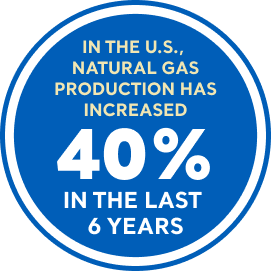
NATURAL GAS EXPORTS
Gross U.S. natural gas exports, through LNG and piped exports to Mexico and Canada, accounted for almost 20 percent of total U.S. gas production, and that trend is projected to increase by 2030. Over the next few years, it’s likely our natural gas demand will outpace supply. This could mean higher prices here in the U.S.
Additionally, pipeline and LNG buildouts in Texas and Louisiana suggest Henry Hub prices could become more linked to higher global gas prices — and less linked to the Appalachian area — which would add more volatility to the market.

NATURAL GAS AND POWER GENERATION
As coal retirements continue in the U.S., the power industry is increasingly reliant on gas generation, leading to competition among power generation, industrial usage, LNG exports, and heating.
As gas can no longer rely on coal to bail it out of soaring prices, there’s limited price elasticity within the power stack. This means, you guessed it, potentially higher prices for consumers.
PRODUCER FLEXIBILITY
Over the last several years, many smaller, independent natural gas producers have gone bankrupt, leading to a shift in the industry as larger, publicly traded companies have become more important players. These larger producers are much slower to react to market conditions and shifts in the supply-demand balance.
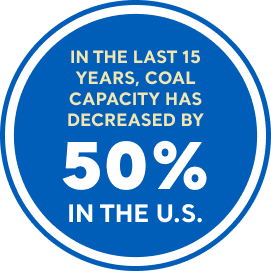

The price of gas will continue to heavily influence the price of power, while demand will increase significantly alongside electrification efforts. This is likely to result in higher prices.
A MASSIVE INCREASE IN ENERGY DEMAND
Though, as a topic, energy has become increasingly politicized, it is, ultimately, a good thing. Consider this: Over the last 200 years, industrial and technological innovation — made possible, in large part, by the access to, and consumption of, energy sources that include fossil fuels — has allowed for significant advancement. Across the world, quality of life has improved, leading to lower poverty and longer lifespans. And, in turn, the global population has increased by seven times in the last 200 years.
This improved quality of life requires a massive amount of energy. It’s estimated that, by 2050, global energy consumption will increase by nearly 50 percent, driven by economic growth in developing countries that are navigating the energy- and emissions-intensive period of urbanization and industrialization that the U.S. experienced more than 100 years ago. Today, these developing nations account for more than 100 percent of the growth in global energy demand. Electricity generation is the largest and fastest-growing sector due, in part, to expanded access to reliable electricity in these developing countries. The increased demand is partially offset by efficiency gains in developed countries.

In the U.S., the EIA reports consumption of all forms of energy will increase by up to 15 percent between now and 2050. (Their growth projection is the result of the effects of economic and population growth, as well as increased travel, offsetting continued energy efficiency improvements here in the U.S.)
In the industrial sector, the growth will be more significant, with the EIA reporting industrial energy consumption will increase between 5 and 32 percent between now and 2050, dependent on economic growth.

The share of U.S. electricity consumed in the residential and transportation sectors is likely to increase most significantly, as space-cooling demands increase and electric vehicles (EVs) gain popularity. The EIA reports household electric consumption is projected to increase between 14 and 22 percent between now and 2050.

Overall, energy demand will continue to climb, even as prices do, challenging producers to keep up and leading to greater market volatility.
THE GLOBALIZATION OF THE ENERGY MARKETS
Another significant long-term factor affecting the industry and consumers is the fact that the U.S. energy market is increasingly driven by global energy demands. In recent years, U.S. exports of natural gas — notably LNG — have grown substantially.
The U.S. has been an annual net total energy exporter since 2019, and since producers began exporting LNG in 2016, it’s served as a massive driver of our nation’s role in the global energy market. Today, the U.S. has more LNG export capacity than any other country — and has exported more LNG than any other country as well.
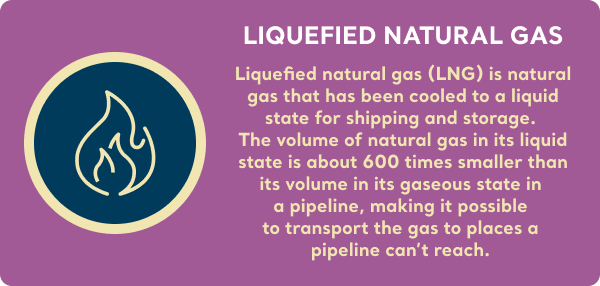
Just in the last decade, the U.S. natural gas market has increased nearly 50 percent, from producing about 24 trillion cubic feet (Tcf) to 35 Tcf of natural gas annually.
The globalization of the energy market also means we’re more concerned with energy security: The increased importance placed on energy security as a result of the conflict between Russia and Ukraine could lead to a shift away from imported fossil fuels toward locally produced alternatives, potentially accelerating the transition to clean energy production here in the U.S.
.png)
NEW SOURCES OF GENERATION ON THE GRID
As a result of momentum behind clean energy technologies, greater emphasis on energy security and reliability, and government action, the U.S. energy grid is changing rapidly.
According to the International Energy Agency (IEA)’s World Energy Outlook, the energy landscape will change dramatically by 2030, with global demand for coal, oil, and natural gas all peaking this decade — the first time the organization has seen this scenario in their annual report. The IEA reports the share of fossil fuels in global energy supply, which has held steady around 80 percent for decades, will decline to 73 percent by 2030.
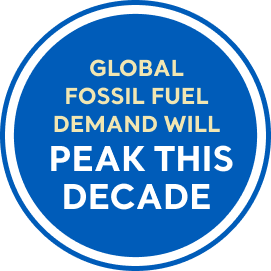

While fossil fuels — notably natural gas — are still essential for meeting domestic energy demand, cleaner energy sources are becoming a large and economically viable part of the generation and consumption mix in the U.S. And declining costs for solar panels, wind turbines, and battery storage — as well as government subsidies, such as those included in the Inflation Reduction Act (IRA) — have resulted in renewables becoming increasingly cost-competitive when building out new power capacity.
When built out and online, wind and solar power are the lowest-cost resources to meet our growing electricity demand, as they don’t have associated fuel costs. Over time, the combined investment and operating cost advantage will increase the share of zero-carbon electricity generation.
By 2030, the share of fossil fuels in global energy supply will fall to 73%.
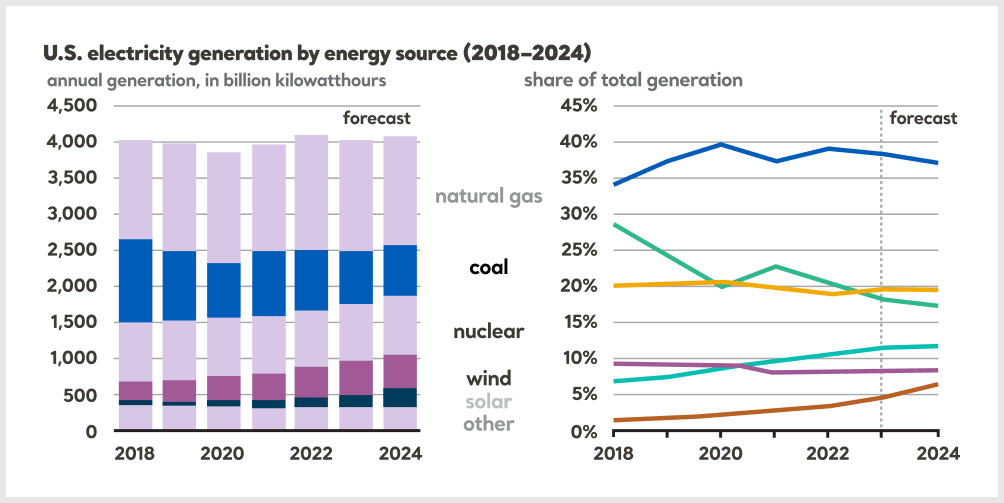
There’s a lot to celebrate about this shift: The IEA reports global energy-related carbon dioxide (CO2) emissions will peak by 2025. And in their Annual Energy Outlook for 2023, the EIA reported total energy-related CO2 emissions in 2050 will be 17 percent lower than what was forecasted in their 2022 report. The primary factors contributing to this change include the broad impacts of the Inflation Reduction Act, updates to technology costs and performance across the energy system, and changes in the macroeconomic outlook. (Graph data courtesy EIA, 2023.)
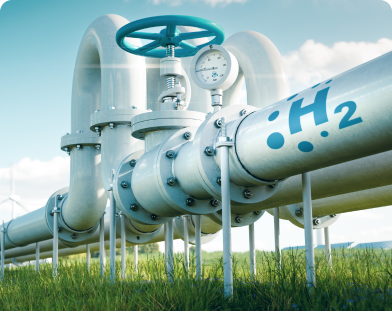
THE ROLE OF HYDROGEN
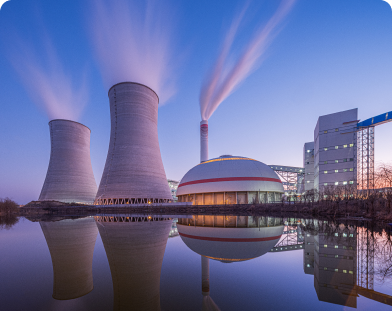
THE ROLE OF NUCLEAR
There’s little doubt that nuclear will play an important role in a clean energy future — but the extent of its role is still up for debate. While nuclear energy is clean and reliable, most of the 93 nuclear reactors in the U.S. are approaching the end of their respective Nuclear Regulatory Commission license terms, and bringing new reactors online is an expensive and time-consuming process.

THE ROLE OF INNOVATIVE NEW SOLUTIONS
We produce more than 70 million tons of organic waste in the U.S. each year — which offers a unique opportunity for powering our homes and businesses. Biogas is produced when organic materials from plants and animals are broken down by bacteria in an oxygen-free environment, a process called anaerobic digestion. Biogas systems use this process to recycle these materials, turning them into biogas, which contains both energy and valuable soil products. This form of gas has a net-negative carbon impact.
IN THIS REPORT, WE HIGHLIGHT THE KEY ENERGY TRENDS AND TOPICS MOST AFFECTING THE ENERGY INDUSTRY — AND CONSUMERS.
Dive into the next section below.




